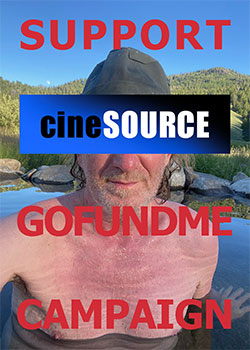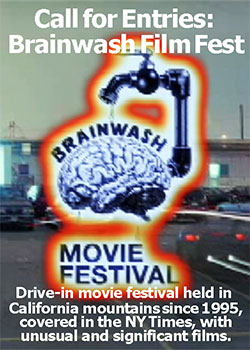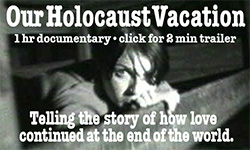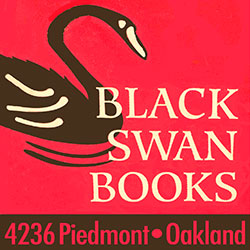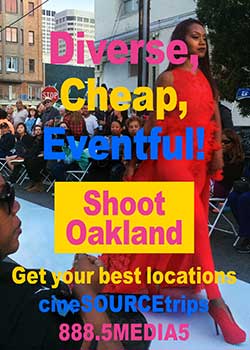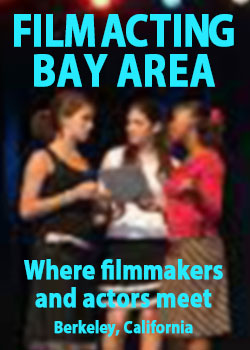Letter from Oakland, Part II
by Doniphan Blair
Please support our stories by liking articles—thanks!
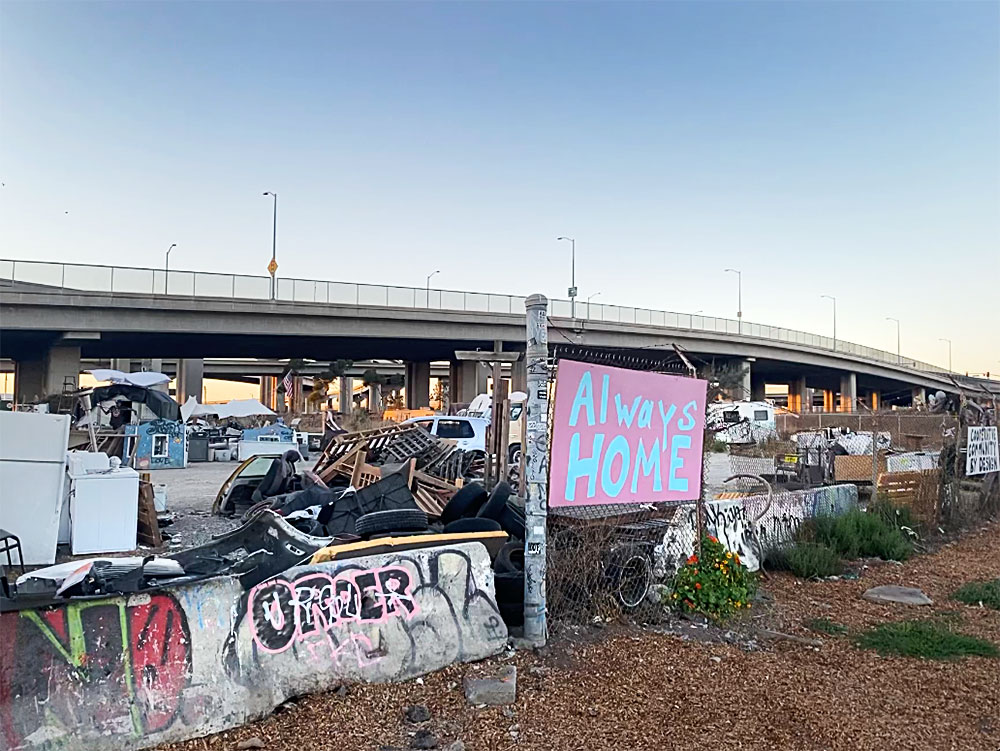 One of Oakland's largest unhoused encampments, home to some, a den of thieves to others, is in West Oakland. photo: D. BlairContinued from Letter from Oakland, Part I
One of Oakland's largest unhoused encampments, home to some, a den of thieves to others, is in West Oakland. photo: D. BlairContinued from Letter from Oakland, Part I
Indeed, Oakland is rich and talented enough to fix its problems, according to my neighbor Jermaine, who was raised in a Chicago hood by a drug-addicted mom. The gang war he witnessed from our loading dock comes from increasing lawlessness, he told me. Heading Jermaine’s fix-it list are the homeless encampments, which are common up and down the West Coast but over the top in Oakland, where they include fully 1% of the population. Although aggravated by gentrification, the homeless camps only started after the Occupy movement established that camping in public spaces would be tolerated, and then they distributed tents.
Many of the town’s biggest camps are in West Oakland. While they provide a release valve for society’s rebels or outcasts, they are rife with addiction, theft, sex abuse and the dangerous tactic of torching rivals’ tents, according to my friends who work with the unhoused as activists, social workers or firefighters, or who live nearby.
Oakland never burned during the nation-wide riots of 1964 through ’68, the last year because the Black Panthers advised against it. By the time Vice President Kamala Harris was born here in ‘64, it was becoming a remarkable multicultural and artistic city, the center of the Bay Area Figurative Movement (of painters) with a world-class art school, California College of Art.
Times were tough for Oakland's proletariat, due to downturns at the port and in many industries. Nevertheless, most residents still had access to elevated opportunities for friendships, education (the University of California at Berkeley is four miles down Telegraph Avenue from downtown Oakland) and employment. When the Rodney King riots erupted in Los Angeles in 1992 and spread to San Francisco and Berkeley, there were no riots in Oakland.
America’s history of slavery and ongoing racism are important subjects for study and debate, especially when contextualized within America’s democratic evolution, but making it the centerpiece of Oakland’s current catastrophe belies the obvious. Indeed, critical race theory can sometimes sound like a conspiracy theory—a monstrous unaddressed evil is sabotaging society—which is problematic in Trumpian times, when so many Americans believe his Big Lie about election fraud and other conspiracy theories.
In point of fact, Oakland has been a “chocolate city” for fifty years, having birthed the Panthers in 1966 and, in 1977, elected its first Black mayor, Lionel Wilson, another McClymonds High School graduate. He served for 14 years, the second longest term in Oakland history. (Panther co-founder Bobby Seale ran for mayor in ’72 and came in second out of nine.) And there have been two more Black mayors: Elihu Harris, 1991 to ‘99, and Ron Dellums, 2007 to ‘11.
While whites continued to hold the vast majority of power and African American Oaklanders dropped from 47% of the population n 1980 to 29% today, many people of color became city employees, entrepreneurs, politicians, professionals, artists, and professors, as was the case with Newton’s brother and Harris’s parents. They also became cops.
Ersie Joyner, who was still recovering two months later from the unbelievable 22 gunshots he survived in October, emerged from poverty in East Oakland to become a respected officer. He was involved in a police shooting a decade ago, for which the department paid a wrongful death settlement of $75,000, but he claimed he was confronting an assailant about to commit a murder. Not only did Chief Armstrong and Oakland Mayor Libby Schaaf praise Joyner highly after he was shot, he was an early advocate of defunding the police.
“My whole entire career I have been taught, I have trained, and I have worked towards eliminating gangs,” Joyner told a reporter from The Guardian in 2019. “That has failed miserably for us for decades.” For most of the last decade, Joyner led Ceasefire, Oakland’s anti-violence program, which is known nationally and was instrumental in reducing Oakland’s murder rate.
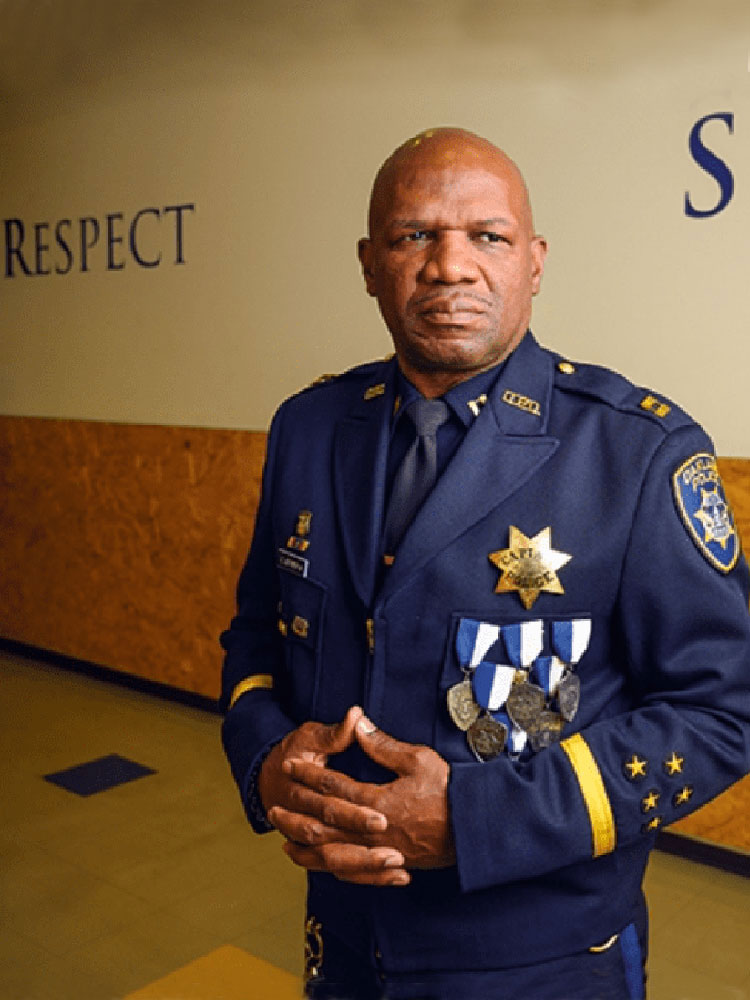 Ersie Joyner: ex-OPD captain and head of Ceasefire, a gang intervention program, as well as, more recently, cannabis entrepreneur and shooting victim. photo: courtesy TGTimeWhat Chief Armstrong is calling for—for Oaklanders to take to the streets and internet to militate against the slaughter—did happen in 2006, after murders jumped to 145, 20% over the previous year. Pastors, politicians and teachers walked the streets to send a strong personal and public signal. My graphic studio submitted a proposal for an ad campaign using photos of funerals and street memorials and the slogan “Murder is fun for the whole family,” although it wasn’t funded.
Ersie Joyner: ex-OPD captain and head of Ceasefire, a gang intervention program, as well as, more recently, cannabis entrepreneur and shooting victim. photo: courtesy TGTimeWhat Chief Armstrong is calling for—for Oaklanders to take to the streets and internet to militate against the slaughter—did happen in 2006, after murders jumped to 145, 20% over the previous year. Pastors, politicians and teachers walked the streets to send a strong personal and public signal. My graphic studio submitted a proposal for an ad campaign using photos of funerals and street memorials and the slogan “Murder is fun for the whole family,” although it wasn’t funded.
Little of that ilk has been organized of late, save for the OPD’s small march in July. I’m guessing activists assume such efforts would cast aspersions on last summer’s hard-won reforms, hand critics a wedge issue, and be of little use, due to ongoing systemic racism.
There is also the class question. Middle class African American families, from which many activists hail, famously give their kids “the talk,” about what to do when harassed by cops. Often left unmentioned is their more frequent lectures on thugs and gangs. Indeed, they have to fight harder on that front, since some of their kids like to prove themselves by running wild. Caught between those two mortal threats, they are understandably reluctant to get involved in gang abatement.
Defunding a police department, or reforming it and redirecting some monies, is direly needed in jurisdictions which militarized or failed to integrate their police or increase social services. But that doesn’t really describe the OPD, which has long had some innovative practices, including collaborating with activists and therapists, but has struggled to find sufficient funding for decades.
When the notoriously liberal but also pragmatic Jerry Brown served two terms as Oakland’s mayor in the 2000s, between his four respected terms as governor, he tried to expand the force by 100 officers. Many Oaklanders of color liked Brown and voted for his additional-police ballot measure, but the measure funding it was defeated. With 681 officers today, the department is about 50 officers below Brown’s hoped-for levels 15 years ago.
OPD was docked $14 million during BLM Summer, with another $22 million lost from pandemic-related tax revenue drops, equaling five and seven percent of its budget. In the meantime, OPD’s case-solved rate went from a half to a third, although Armstrong did shift six detectives to homicide, and he recently claimed the department had cracked ten murder cases. OPD fields up to 2000 911 calls daily, one of the highest calls-per-officer rates in the country. After hearing the shots that killed Rashad Brinson, I called 911 three times before getting through.
Although the city shifted another $18 million to social services in June 2021, it did allocate $38 million for more police academies, i.e. classes of recruits, to cover the perennially low levels and the many officers who are quitting. One academy will graduate in January 2022 and another in May. A big problem, however, is those recruits, an Oakland friend recently told me, since the vast majority are not from Oakland, let alone its inner city.
Be that as it may, the OPD has been comparatively well integrated for decades and now includes some Asian officers and members of the city’s artistic community. Jinho Ferreira (Black/Latinx), who rapped as “The Piper” while an OPD officer, also wrote the well-received, one-person play, “Cops and Robbers” (2012), which examines its opposing protagonists notably sympathetically.
Police killings, especially those resembling executions, instead of fog-of-war errors, are criminal, culturally corrosive and incendiary offences, naturally alienating people from authority and society and fueling the anger of volatile young men.
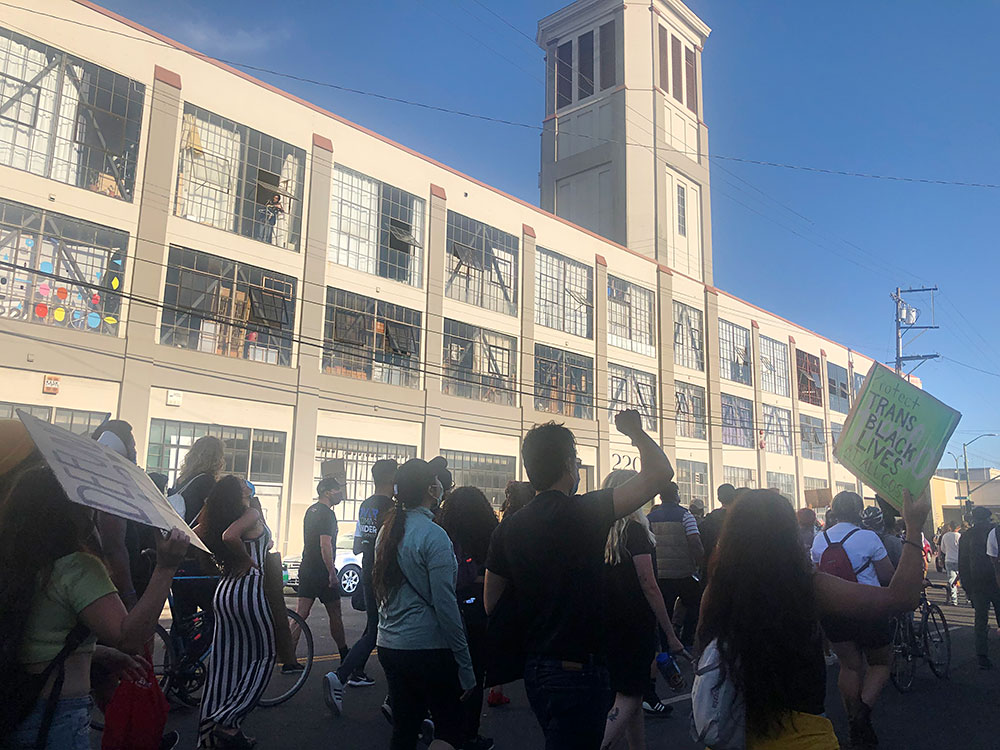 A June 2020 Black Lives Matter march passes in front of Blair's building on West Grand and Adeline, West Oakland. photo: D. BlairAccording to the Anti-Eviction Mapping Project, Oakland-connected cops killed 102 people from 1970 to 2015. Of the 93 victims that could be racially identified, 97% were of color and around two thirds Black. But those police murders are still small, by factors of 30, 40 or more, compared to inner-community killing. Indeed, in those 45 years, over 3000 Oaklanders of color were killed by each other.
A June 2020 Black Lives Matter march passes in front of Blair's building on West Grand and Adeline, West Oakland. photo: D. BlairAccording to the Anti-Eviction Mapping Project, Oakland-connected cops killed 102 people from 1970 to 2015. Of the 93 victims that could be racially identified, 97% were of color and around two thirds Black. But those police murders are still small, by factors of 30, 40 or more, compared to inner-community killing. Indeed, in those 45 years, over 3000 Oaklanders of color were killed by each other.
Moreover, fratricide is more difficult to process psychologically than outsider aggression since it hits in the home. While external enemies can be criticized aggressively and publicly, as demonstrated during BLM Summer, internal oppressors are often downplayed or denied. Then the repressed anger is transferred to a more palatable opponent, hiding the injury and making it harder to heal.
Oakland’s Black community has hundreds of churches, large and small, and their pastors and parishioners do a fantastic job. I have seen them hand out food, provide medical services, set up a community recording studio, and even save the elderly parishioners living next door to my building from a fire, before the arrival of the fire department. But to address our current crisis, which is aggravated by the two major crises of our era, the pandemic and Trumpism, they don’t have much street cred.
For that, the organizers of an “Oakland United Against Violence,” or similarly-named march, concert or social-work symposium could turn to Oakland’s many famous rappers or basketball stars. Or they could tap Alicia Garza, a founder of Black Lives Matter (who was born in Oakland but moved to wealthy Marin County and returned at age 27), Angela Davis, the internationally-known thinker, professor and friend of the Black Panthers, or Boots Riley, the brilliant indie rapper turned filmmaker, who shot his masterful and scathingly satirical debut feature "Sorry to Bother You" around Oakland in 2017 (see cineSOURCE article).
Many of Oakland’s creatives and entrepreneurs have the skills to organize concerts, clinics or neighborhood fitness or media centers, preferably located on or near crack corners. Or to contribute fresh ideas. The Oakland Occupy drew denizens from all walks of life and hoods to fruitful encounters and discussions in front of the mayor’s office. Alas, Mayor Jean Quan, a woman, Asian and longtime activist, was unable to find a way to channel that energy or hybrid it with city services.
“Blindspotting”, another excellent Oakland indie feature, which builds an interracial bromance into a political and operatic epic, was written by and stars Oaktown homies and old friends, Rafael Casal and Daveed Diggs, the latter fresh off his New York star turn as Thomas Jefferson in “Hamilton” (see cineSOURCE article). Filmed largely in West Oakland, also in 2017, they set their white cop’s murder of a Black man on West Grand and Adeline, my corner. Alas, there have been no police murders here in the last three decades, while well over 150 of my neighbors in a few block radius have killed each other.
“Blindspotting”, “Sorry to Bother You” and other recent films artfully address police killings and institutional racism, but when it comes to Oaklanders butchering each other, it’s slim pickings. Nevertheless, there were a couple of spectacular, low-budget films wading into that morass, notably “Licks”, which is slang for the corner liquor stores the film’s protagonists like to rob, and “Everyday Black Man” by my friend Carmen Madden.
“Licks” was directed in 2012 by Jonathan Singer-Vine, a white, Jewish twenty-something from Berkeley whose Oakland friends, some living deep in the hood, obviously loved the project and worked incredibly hard on it. With a largely amateur cast, they produced a striking, professional film which delves deep into thug life.
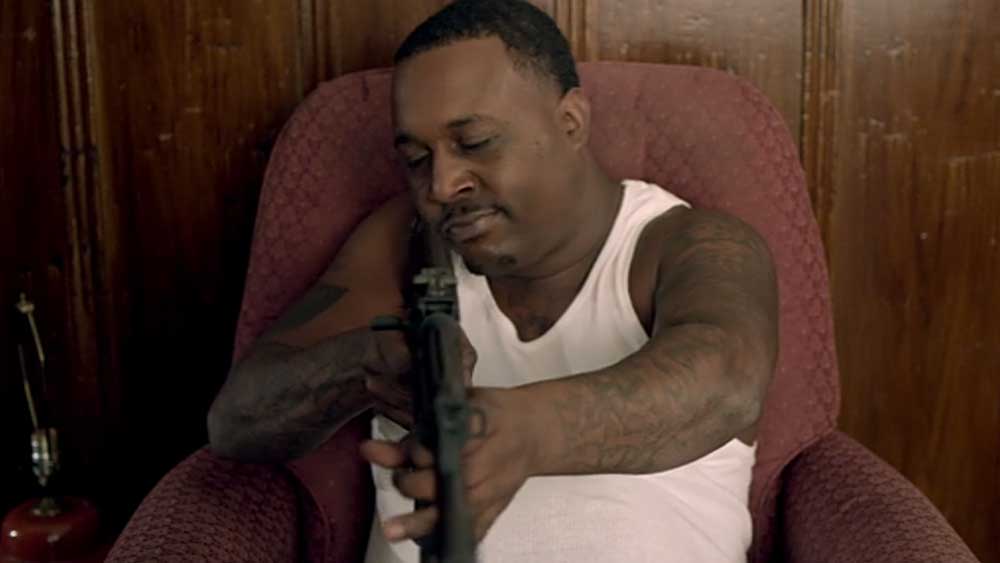 Big John, played by Steve Joel Moffet Jr., is one of the toughest characters in 'Licks', the groundbreaking Oakland movie by Jonathan Singer-Vine. photo: courtesy J. Singer-VineSinger-Vine made the proprietor of his “lick” Black for story telling purposes, but the vast majority of corner liquor store owners are Arab-Americans, often Yemeni, which typifies Oakland’s advanced multiculturalism. Due to the demand for credit and prevalence of alcoholism, Blacks are disadvantaged running liquor stores in their own communities, but Yeminis are Muslims whose culture discourages drinking. A friendly, well-adjusted group, but also quite traditional, even though many of their grandfathers immigrated in the ‘70s, the Yemini-Americans are also very well-armed.
Big John, played by Steve Joel Moffet Jr., is one of the toughest characters in 'Licks', the groundbreaking Oakland movie by Jonathan Singer-Vine. photo: courtesy J. Singer-VineSinger-Vine made the proprietor of his “lick” Black for story telling purposes, but the vast majority of corner liquor store owners are Arab-Americans, often Yemeni, which typifies Oakland’s advanced multiculturalism. Due to the demand for credit and prevalence of alcoholism, Blacks are disadvantaged running liquor stores in their own communities, but Yeminis are Muslims whose culture discourages drinking. A friendly, well-adjusted group, but also quite traditional, even though many of their grandfathers immigrated in the ‘70s, the Yemini-Americans are also very well-armed.
For thirty years, I have known the members of the extended family which owned and worked in my corner lick, where Rashad Brinson was killed in October. Indeed, their saga is central to local gossip, giving me a leg up at local gatherings. In addition to brandishing weapons to defend themselves on many occasions, they have shot a few assailants, and one, Willy, accidentally shot himself (he survived).
“‘Licks’ is so studded with the N-word and local slang, like ‘whip’ for car, as to be almost unintelligible,” I wrote in my 2017 review of the film for cineSOURCE. “[I]ts denigration of women—many of its protagonists are pimps, although they adore their mothers and grandmothers—makes it almost unwatchable.” But also accurate, it would seem.
When Singer-Vine finally found a distributer, the suits wouldn’t release “Licks” unless he cleaned it up—the commercial wing of the PC police. He refused, hence its four-year delay before appearing on Amazon Prime in 2017. “Licks” still hasn’t gotten proper promo or viewing, even around Oakland, despite its elevated insights (see it here). As is commonly known, as well as well confirmed by research, people respond to honest stories about their issues.
In contrast, “Everyday Black Man”, shot in Oakland in 2009, was by a woman about men. Madden, who is African American and grew up mostly in Oakland’s suburbs, started as an actress and became an accomplished teacher, writer and director. “Everyday Black Man”, her first feature, tackles the even thornier subject of corruption among community leaders (see it here). Although the story follows another Black lick owner and his hiring of a Black Muslim man, who turns the store into a front for drug dealing, Oaklanders knew Madden was referencing the murder of Chauncey Bailey.
A well-regarded reporter and the editor of The Oakland Post, who was African American, Bailey was killed downtown in 2007 by a paid assassin with a long gun. He was about to publish another article exposing the criminal activities of the owners of the once-popular Your Black Muslim Bakery. After the hit man turned state's evidence, they got life without parole.
Many of Oakland’s progressive elite also oppose full freedom of speech, if it reflects poorly on a disenfranchised community. Almost 20 years ago, Ron Dellums, the first Black congressperson from Northern California, who was also an anti-war activist and socialist, and the mayor of Oakland in the late ‘00s—as well as a West Oaklander who attended McClymonds—led the campaign to cancel “Gentlemen of Leisure”, a proposed television series.
It was based on “American Pimp”, the critically-acclaimed 1999 documentary about West Coast pimps, many from Oakland, by the Hughes brothers, who are Black. To have been shot in Oakland, the show was supported by Madden and other creatives and would have been a feather in the cap of the city’s fledgling film business, perhaps even paralleling what “The Wire” (2002-8) did for Baltimore.
But “Gentlemen of Leisure” would not have looked good for the airbrushed Oakland Dellums and other city elders were trying to sell gentrifiers to revive Oakland’s tax base. (Mayor Brown said he would build 10,000 dwellings, Mayor Dellums 100,000.)
Oakland is cursed by the California conundrum of being comparatively rich, beautiful and liberal, which makes its poverty, ugliness and repression more grotesque. That very quality, in fact, drives its disadvantaged to more extreme anger, envy and ambition. As the poorest of the fabulous cities by the bay, Oakland is an automatic loci of crime, simply because ambitious poor people will always sell two very popular products and services: drugs and sex. As painful as that is for my more bourgeois or politically-correct neighbors to contemplate, it requires in-depth exploration through research, sociology and art.
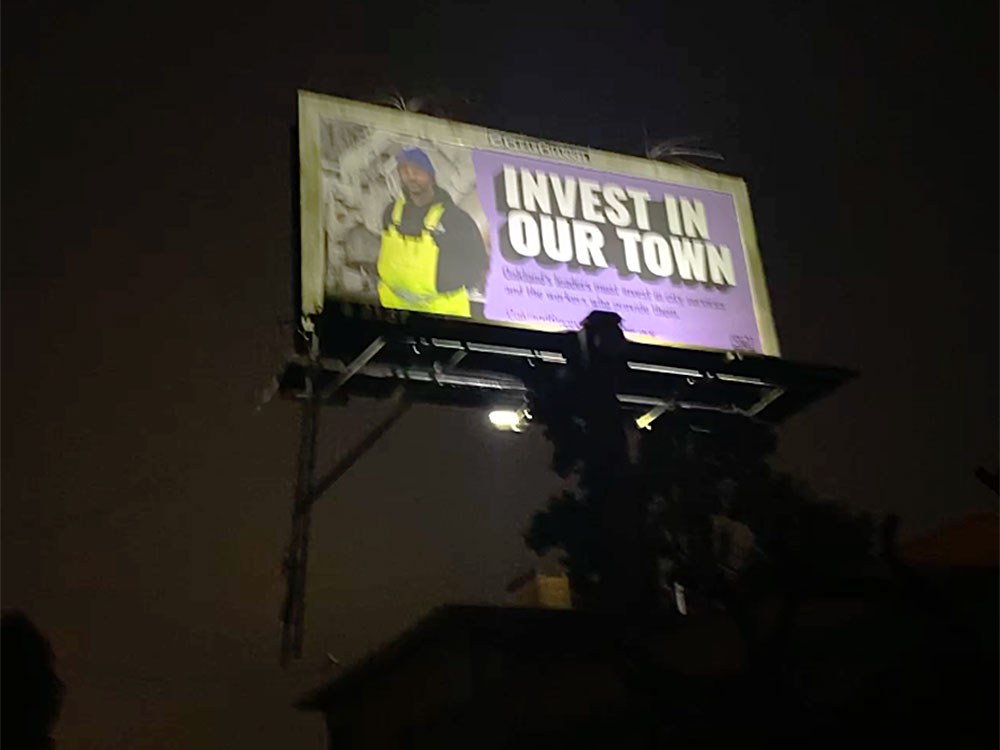 The Oakland mayor's office put up lackluster billboards, while more creative submissions were rejected. photo: D. BlairProstitution has long been a popular profession in semi-matriarchal societies, where it is not as stigmatized, and all oppressed groups are semi-matriarchal, since the men are injured, removed or absent. In addition, many tribes are semi-matriarchal, including in West Africa, traditions which helped African Americans endure the destruction of the family during slavery.
The Oakland mayor's office put up lackluster billboards, while more creative submissions were rejected. photo: D. BlairProstitution has long been a popular profession in semi-matriarchal societies, where it is not as stigmatized, and all oppressed groups are semi-matriarchal, since the men are injured, removed or absent. In addition, many tribes are semi-matriarchal, including in West Africa, traditions which helped African Americans endure the destruction of the family during slavery.
The “talented tenth” of Black men rebuilt their personal patriarchies through hard work, the arts or professions, but the less skilled looked to boom towns, like Oakland during World War II, to become fully vested family men. As those jobs waned, they suffered, while women joined the workforce, sometimes with notable success. The revival of matriarchal traditions is largely why out-of-wedlock births are now hitting historical highs among African Americans and why the lure of becoming a gangster, with increased reproductive opportunities, is so attractive. It also seems many of the inner-communal killings are jealousy driven, as appears to have been the case with the young man killed behind my building on June 25th, 2021. During the pandemic, many murders were inspired by watching rivals have fun on social media.
It is no surprise that Oakland became the center of Northern California’s enormous legal as well as illegal marijuana industry, which is mostly white owned (even though the legacy busines until 1980 was largely Black and Latino). Oakland has Harborside, one of the biggest weed stores in the world, Oaksterdam University, the world's first cannabis college, and many related classes, services and stores, from supplies and equipment to dispensaries and manufacturing.
Indeed, retired-Captain Joyner now runs the Joyous Recreation and Wellness Group, a cannabis edibles manufacturer, located in an unmarked warehouse four blocks from my house. Since the cannabis industry, which started legalizing in the US in California in 1996, is still not permitted banking services, its workers often carry large amounts of cash. This led some journalists to speculate Joyner was not a random robbery victim.
With Oakland an ongoing prostitution and drug center, people assume some of its police simply must be on the take, an opinion which increased after the OPD’s spectacular sex scandal of 2016. That imbroglio was made even more memorable when Mayor Schaaf, who had been special assistant to Mayor Brown and assumed office in 2015, fired three police chiefs in one week.
Captain Sean Whent had been doing a decent job for three years, according to “The Force” (2017), a documentary by Emmy-award-winning Oakland filmmaker Peter Nicks, which has some good clips on Armstrong. Nicks's previous film, the acclaimed “The Waiting Room” (2012), was about the emergency room at Oakland’s main hospital, Highland, which is known nationally for its gunshot surgery miracles. (I was waiting for treatment once when a young Black man was wheeled in, bleeding but bragging into his phone, “I was shot, I was shot.”)
Unfortunately for Nicks, he wrapped principal photography just before the story broke about a suicide, a murder, and dozens of cops being involved with a 17- then 18-year-old woman of color with an hourglass figure, known by her assumed name, Celeste Guap. As it happened, Ms Guap’s mother was an OPD dispatcher and had many friends on the force, including Officer John Hege, who helped her escape an abusive husband and was beloved by Guap. Both were devastated when Hege was one of the four Oakland cops killed that same day in 2009.
Coercion by powerful figures and child sex abuse were the issues raised by Guap’s lawyers to win her $1 million dollar settlement from the city, and they remain her talking points today, but the actual affair was probably a bit more, well, Oakland.
The story starts with a white, increasingly-disturbed rookie cop named Brendan O’Brien, whose Latina wife committed suicide, after they argued about him possibly having an affair. But her family thinks he killed her, and ex-OPD detective Mike Gantt agrees. Indeed, he was pushed off the case by department brass protecting their own, he says, and he filed a related claim against city officials. The intricate evidence was reported at length in The East Bay Express, by Darwin Bond Graham and Ali Winston (see it here), but the facts remain somewhat ambiguous to me.
 Celeste Guap (her working name): a young Oakland woman who had family friends and boyfriends in the Oakland police and was also a sex worker. photo: courtesy C. Guap's Facebook pageAt any rate, O’Brien was exonerated and went back to work. A year after his wife died, he encountered Guap on International Boulevard, the Latinx neighborhood where she liked to sex work, since her family is Nicaraguan. Guap was being harassed by her pimp and hailed a passing patrol car. “He saved me,” she said of O’Brien, although he didn’t bring her to one of the many related social services or turn her over to a guardian, as recommended by Oakland’s progressive sex trafficking directives. Meeting again two weeks later at a taco truck, no less, they started dating. She was 17, he mid-20s.
Celeste Guap (her working name): a young Oakland woman who had family friends and boyfriends in the Oakland police and was also a sex worker. photo: courtesy C. Guap's Facebook pageAt any rate, O’Brien was exonerated and went back to work. A year after his wife died, he encountered Guap on International Boulevard, the Latinx neighborhood where she liked to sex work, since her family is Nicaraguan. Guap was being harassed by her pimp and hailed a passing patrol car. “He saved me,” she said of O’Brien, although he didn’t bring her to one of the many related social services or turn her over to a guardian, as recommended by Oakland’s progressive sex trafficking directives. Meeting again two weeks later at a taco truck, no less, they started dating. She was 17, he mid-20s.
Whether the relationship was coerced or consensual, we won’t know until Guap does a podcast, book or movie, but there must have been some romance, given the rumors and fantasies that started flying around. Indeed, Ms Guap became the object of rapt attention of dozens of police officers from departments around the Bay Area, an adulation she evidently enjoyed.
After a months-long, half-bromance, half-serial orgy, O’Brien killed himself after Guap threatened him—during a drunken phone call from Puerto Rico, where she was vacationing—that she would reveal she was screwing lots of cops. Instead, O’Brien’s suicide note brought that fact to the attention of authorities.
As soon as Mayor Schaaf heard, she fired Chief Whent. But when she tried to replace him with a lieutenant captain, it came out he recently had an extramarital affair. When her second appointee realized he wouldn’t fare well in the spotlight and resigned, Schaaf took over managing the department herself, through the mayor’s office. Eventually, her staff recruited from Spokane Anne Kirkpatrick, whom Schaaf must have hoped would help with the OPD’s testosterone problem.
The scandal was enormous, involving cops from as far as Livermore and San Francisco. Yet the OPD only expelled four officers, suspended seven, and left a dozen unidentified. The released version of the department’s long internal report, completed in 2019, is over half redacted. Eyebrows shot up again when officials running the flawed investigation were promoted, and two incriminated officers stayed on the force. They had had sex with Guap and texted lascivious notes to fellow cops, but after she turned 18.
Guap’s mother told a retired cop who was a family friend about the abuses, but he didn't report it. Alameda County filed numerous charges, but almost all were eventually dropped.
The OPD’s 2016 sex scandal is one back story illuminating an aspect of Oakland’s descent into violence. Another is the Black Panthers.
The Panther’s three founders, Newton, Seale and late-arriving but brilliant and already-published Eldridge Cleaver were visionary, hardworking and innovative. In a spectacular bit of political theater, they took over the California capitol, in Sacramento, in May 1967, brandishing their trademark long guns (see cineSOURCE story). As well as providing inspiration and ideas to Black people across America and then the world, they started a children’s breakfast program, newspaper, medical clinic and other essential services. Along the way, they were confronted by relentless attacks from authorities and infiltrators but also Newton’s proclivity for violence.
After two juries failed to reconvict Newton on appeals of his cop-killing conviction, he was freed in 1970. Picked up from San Quentin Prison by his close friend Bert Schneider, a Hollywood producer in a white Cadillac, he was driven to a heroes’ welcome in Oakland, where he hopped on a car, stripped to the waist and exhorted revolution. Newton proceeded to tour the nation, China and elsewhere as America’s most acclaimed revolutionary. After another arrest, for allegedly murdering two women, he fled to Cuba but returned and was found innocent again.
In 1980, Newton earned a PhD from U.C. Santa Cruz with his easy-to-research thesis “The War Against the Panthers”, although, by that time, he had long been a gangster. Vying to become Oakland’s top pimp daddy, he took up residence in a fancy penthouse overlooking Lake Merritt and the Oakland court house, where he spent so much time. Even while maintaining his grueling schedule of writing and public appearances, he led a hard-nosed crew which allegedly extorted protection money from bars and other businesses, ran coke, to which he became addicted, and pimped some Panther sisters.
“I probably would have killed Huey myself,” remarked his erstwhile-best-friend Seale. Newton was finally murdered in 1989, about a mile from my building, a few months after I moved in. It was considered a standard Black-on-Black attack until it came out he had been killed by a member of a rival revolutionary group, the Black Guerrilla Family, in a coke deal gone bad.
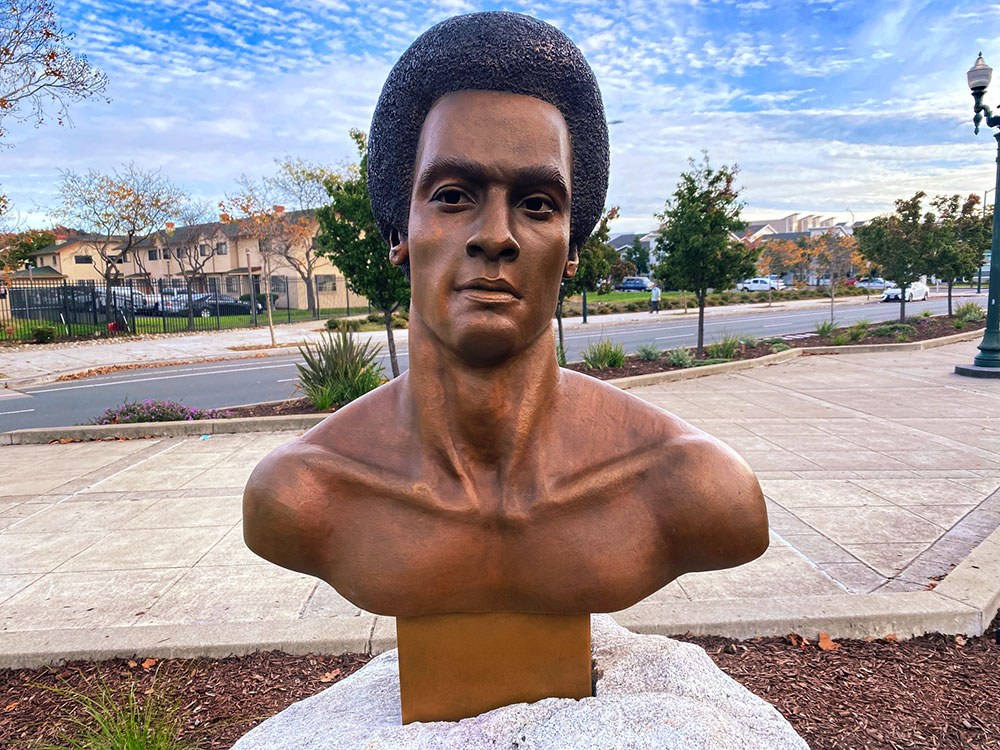 Memorial to Huey P. Newton, co-founder of the Black Panthers, who grew up and died in West Oakland. sculpture: Dana King photo: D. BlairAlthough Newton is honored in many books, classes and murals around the country, not a single monument was erected in his home hood of West Oakland for fifty years. When the Panthers held rallies at DeFremery Park, the crowds were mostly white kids from Berkeley, San Francisco and the Oakland hills. The Black middleclass families, of which there were many in West Oakland’s beautiful Victorian houses, opposed the Panthers’ sex and drug use as well as radical politics, and struggled to keep their kids away.
Memorial to Huey P. Newton, co-founder of the Black Panthers, who grew up and died in West Oakland. sculpture: Dana King photo: D. BlairAlthough Newton is honored in many books, classes and murals around the country, not a single monument was erected in his home hood of West Oakland for fifty years. When the Panthers held rallies at DeFremery Park, the crowds were mostly white kids from Berkeley, San Francisco and the Oakland hills. The Black middleclass families, of which there were many in West Oakland’s beautiful Victorian houses, opposed the Panthers’ sex and drug use as well as radical politics, and struggled to keep their kids away.
A friend of mine, Rick Moss, told me how the mother of a friend of his stridently blocked their attempt to join the Panthers’ San Francisco chapter in the ‘70s. As the director of Oakland’s African American Museum and Library, Moss mounted a Panther show in 2016 to commemorate their 50th anniversary but edited out Newton’s “posturing and showboating.”
Of course, the Oakland chapter of the Panthers was under constant attack by FBI double agents, through its notorious Cointelpro program, as well as by pseudo-revolutionaries, hustlers and local cops, which put them under immense pressure and fomented paranoia. Nevertheless, Newton was egregiously violent. Indeed, his revolutionary hero status and gun-slinger style—which Cleaver captured in his iconic portrait of Newton sitting on an African wicker throne, holding a spear and a gun—contributed to African American gun culture, which ballooned in the ‘70s and led to thousands of deaths.
A small mural of Newton appeared on a West Oakland side street in 2017, but it hardly compares to the deluxe, bronze bust of him without a shirt—Newton liked to strip to the waist to show off his prison pecs and play the rock star, even though that is an odd pose for a radical thinker—which was dedicated in October 2021. Organized by his widow Fredrika and sculpted by Dana King, the golden statue sits in the wide greenway in the middle of Mandela Avenue, a block from where Newton was murdered. The city also named the nearby 9th Street Dr. Huey P. Newton Way.
Before the statue was placed, its stone plinth and accompanying sign were defaced by graffiti tags and the words “fraud” and “fuck you.” Fredrika didn’t call the police, which community members are loath to do, but the community did identify the young male taggers, who apologized, saying they didn’t know what the rock was for. They also helped with the cleanup.
Except for its proximity to where Newton was murdered, the plaque does not reference his gangsterism. While he achieved many successes and wrote a substantial body of work, including the plaque’s quote—“I think what motivates people is not great hate, but great love for other people”—actions speak louder than words when it comes to ethical instruction.
Some of my Oakland friends, as well some radicals, rappers and thug culture aficionados, or actual thugs, are expressing renewed reverence for Newton in statements, songs and T-shirts. But is he an appropriate hero for young Oaklanders? Imagine hearing Newton venerated while growing up but learning his unexpurgated biography in college, say, especially if you lost friends or relatives to gun violence. As with the great writer Gertrude Stein, another larger-than-life Oaklander with feet of clay (she was revealed to have collaborated with French Nazis), we have to examine our heroes and forbearers honestly, just as our woke friends are doing with Columbus and Jefferson.
Would Newton applaud Oakland’s new radicalism or lawlessness? Or would he recognize the US is under attack by entirely different revolutionaries, the Republicans and conspiracy theorists who are threatening democracy and whose policies are decimating poor communities, white as well as Black. Indeed, poor whites are plagued by opiate and amphetamine addiction, the deaths from which doubled during the pandemic to over 93,000 in 2020, and the anti-vax movement and QAnon conspiracy theorists, which have led to hundreds of thousands of unnecessary Covid deaths.
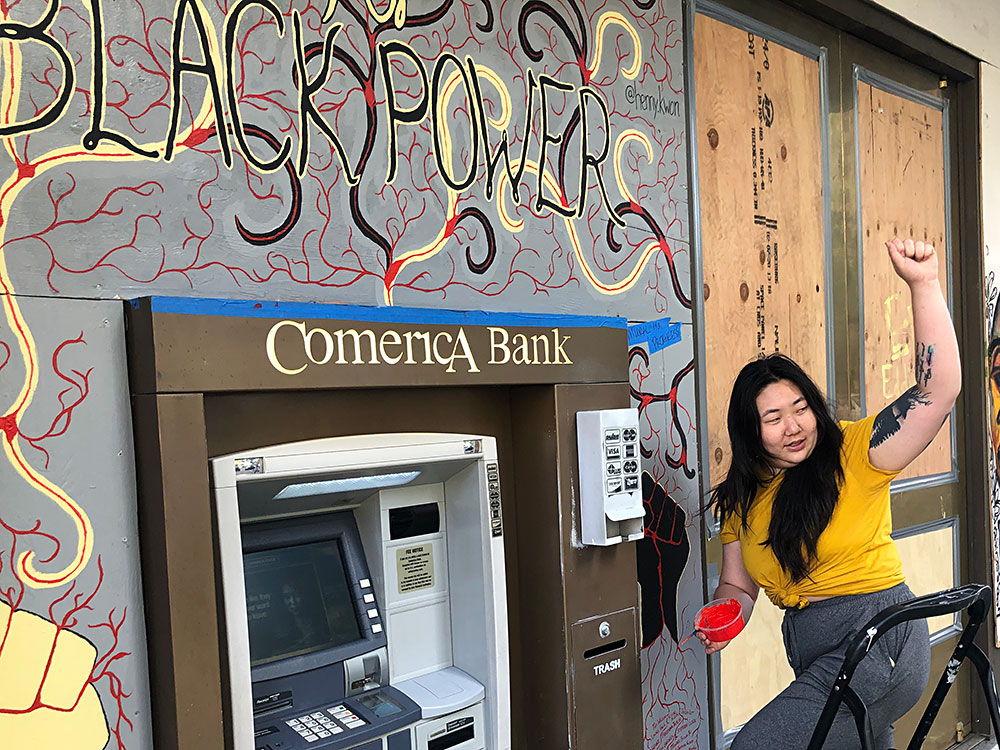 An Oakland muralist, who uses the nom de art 'Yellow Peril', salutes a Black Lives Matter march, June, 2020. photo: D. BlairBack in Oakland, there are so many car break-ins on some streets, residents pot their trees with broken glass. Graffiti bombing is rampant, with celebrity taggers coming from out of town. A few Black men have taken to wearing their pants so low around their thighs, a prison style proving thug bona fides, they could serve as runway models for the fancy underwear they now wear. There are enormous “side shows,” street parties attended mostly by African Americans, involving automotive performances, like doing “donuts” or “ghost riding the whip,” where drivers walk alongside their coasting vehicles. Side shows tie up traffic, frighten locals and sometimes trigger violence.
An Oakland muralist, who uses the nom de art 'Yellow Peril', salutes a Black Lives Matter march, June, 2020. photo: D. BlairBack in Oakland, there are so many car break-ins on some streets, residents pot their trees with broken glass. Graffiti bombing is rampant, with celebrity taggers coming from out of town. A few Black men have taken to wearing their pants so low around their thighs, a prison style proving thug bona fides, they could serve as runway models for the fancy underwear they now wear. There are enormous “side shows,” street parties attended mostly by African Americans, involving automotive performances, like doing “donuts” or “ghost riding the whip,” where drivers walk alongside their coasting vehicles. Side shows tie up traffic, frighten locals and sometimes trigger violence.
The latest innovation by Oakland gangsters is brazen assaults by large groups, like the gang of 50 found burglarizing buildings in West Oakland. On November 19th, 2021, stores around San Francisco’s premier Union Square were looted by a “flash mob” wielding crowbars, smashing glass cases and teargassing security guards. A day later, the high-end Nordstrom store in the Oakland suburb of Walnut Creek was swamped by 80 “shoppers” who suddenly metamorphosed into smash-and-grabbers. On NPR on December 20th, California Attorney General Rob Bonta explained how the thieves coordinate on social media like crime syndicates and sell stolen goods in online markets, which are failing to police themselves.
Similar attacks have transpired from large Home Depot stores to small marijuana dispensaries, despite increases in security personnel and Bay Area counties joining to share information and policing duties. And they are spreading across California and the US.
Over Thanksgiving weekend, well-armed caravans marauded across Oakland and two people, who attempted to mount a defense, were murdered. Retired-OPD sergeant Kevin Nishita, who was Japanese-American but had an interracial family, was working as a security officer for a KRON 4 camera crew, covering a rob-mob incident, when gunmen tried to steal their cameras. Nishita intervened and was shot to death.
Twenty-eight-year-old Erik Davis, an African American from Los Angeles, who had lived in Oakland for a few years and was known for his affable personality, was also shot and killed for confronting brazen thieves, this time those breaking into cars in a public setting. Indeed, it was 3 pm, Thanksgiving Sunday, on an avenue alongside Lake Merritt, a hundred yards from the city’s popular promenade.
Those two murders, combined with the flash mob attacks, two bullets fired directly at police, and the Thanksgiving weekend's tsunami of 911 calls brought OPD to a fever pitch that required calling in off-duty cops. “We were entirely overwhelmed with the staff we had, even by bringing in those officers,” said Barry Donelan, the OPD union’s president, who is white. He also wrote an op-ed piece in The East Bay Times warning how low morale threatened the force with complete collapse.
Mayor Schaaf, for her part, thanked serving officers profusely on camera, offered new recruits a $50,000 signing bonus, and said she would petition Governor Gavin Newsome, another Jerry Brown acolyte, for more resources. Around December 10th, she appealed for more state police and technology, including license plate readers on freeway ramps.
Vice Mayor Kaplan, meanwhile, developed MACRO (Mobile Assistance Crisis Responders of Oakland), the city’s response to clamors for police alternatives, which will be run through the Fire Department. With an emphasis on recruiting community members with lived experience, it intends to provide “an effective civilian response option,” according to an October 20th press release, although it is just a 15-member pilot program. A friend of mine, who used to live in West Oakland and does body work, herbalism and activism, applied but said his odds were slim due to over 1000 applicants.
Also starting around Thanksgiving, Guillermo Cespedes, head of Violence Prevention, organized Town Nights, events held in four parks in tough hoods on four successive weekends. Combinations cook-outs, clothing giveaways, pickup basketball games and community gatherings, they seemed successful, despite the skepticism voiced by Chief Armstrong and others that such festivities could reach violent individuals. The plan is to do a lot of Town Nights in the summer, when violence is the highest, according to the SF Chronicle (12/31/22). Armstrong also announced the allocation of 40 additional officers to East Oakland, where three-quarters of the murders transpire.
Despite the murders and robberies, Oakland’s always-multicultural, often-hipster and sometimes-marijuana-fueled party continued. The week after Thanksgiving, I attended my first First Friday art crawl since the pandemic. Now organized by Oakland First Fridays (.org), it restarted in October. As usual, it was fun, intercommunal and occasionally visionary, with some great people, performances and art but a fraction of its once-enormous crowds.
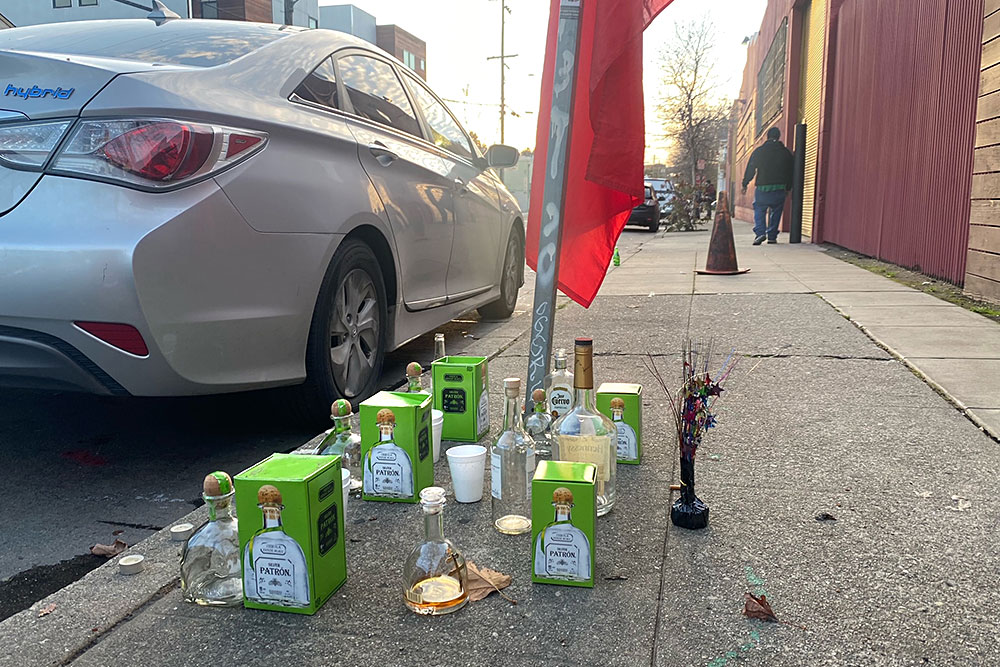 Street memorial for 28-year-old Cameron Windom, Oakland's first murder victim of 2022, killed by a 23-year-old after an argument at 34th and Hollis, a half a mile from Blair's building. photo: D. BlairRace is a large part of the American story. But making it the central theme impugns our robust multiculturalism and egalitarianism, which is especially strong in Oakland, a young city with less hierarchy and racism and more artists, activists and intermarriage than Albuquerque, Nashville or Detroit. Despite the gangsters among our police and radicals as well as illicit-activities entrepreneurs, Oakland’s recent renaissance and current crop of artists, progressive politicians and decent cops suggest we can solve our killing-each-other problem.
Street memorial for 28-year-old Cameron Windom, Oakland's first murder victim of 2022, killed by a 23-year-old after an argument at 34th and Hollis, a half a mile from Blair's building. photo: D. BlairRace is a large part of the American story. But making it the central theme impugns our robust multiculturalism and egalitarianism, which is especially strong in Oakland, a young city with less hierarchy and racism and more artists, activists and intermarriage than Albuquerque, Nashville or Detroit. Despite the gangsters among our police and radicals as well as illicit-activities entrepreneurs, Oakland’s recent renaissance and current crop of artists, progressive politicians and decent cops suggest we can solve our killing-each-other problem.
As well as prevent the murder of more Rashad Brinsons, Lai Dangs or John Heges, Oakland could provide guidance to other communities. For that to happen, however, even more Oaklanders will have to join their neighbors across cultural, racial or class lines, and develop even more innovative methods in education, social work and the arts, as well as policing. Lecturing or arresting will not mollify enraged neighbors willing to seek satisfaction through the barrel of a gun, we have to inspire and offer alternatives.
To comment on this article, go to cineSOURCE's Facebook page.
To see the author's article on Black Lives Matter from July 2020, go here.
Doniphan Blair is a writer, film magazine publisher, designer, musician and filmmaker ('Our Holocaust Vacation'), who can be reached Posted on Jan 08, 2022 - 03:15 PM
by Doniphan Blair
Please support our stories by liking articles—thanks!
 One of Oakland's largest unhoused encampments, home to some, a den of thieves to others, is in West Oakland. photo: D. Blair
One of Oakland's largest unhoused encampments, home to some, a den of thieves to others, is in West Oakland. photo: D. BlairIndeed, Oakland is rich and talented enough to fix its problems, according to my neighbor Jermaine, who was raised in a Chicago hood by a drug-addicted mom. The gang war he witnessed from our loading dock comes from increasing lawlessness, he told me. Heading Jermaine’s fix-it list are the homeless encampments, which are common up and down the West Coast but over the top in Oakland, where they include fully 1% of the population. Although aggravated by gentrification, the homeless camps only started after the Occupy movement established that camping in public spaces would be tolerated, and then they distributed tents.
Many of the town’s biggest camps are in West Oakland. While they provide a release valve for society’s rebels or outcasts, they are rife with addiction, theft, sex abuse and the dangerous tactic of torching rivals’ tents, according to my friends who work with the unhoused as activists, social workers or firefighters, or who live nearby.
Oakland never burned during the nation-wide riots of 1964 through ’68, the last year because the Black Panthers advised against it. By the time Vice President Kamala Harris was born here in ‘64, it was becoming a remarkable multicultural and artistic city, the center of the Bay Area Figurative Movement (of painters) with a world-class art school, California College of Art.
Times were tough for Oakland's proletariat, due to downturns at the port and in many industries. Nevertheless, most residents still had access to elevated opportunities for friendships, education (the University of California at Berkeley is four miles down Telegraph Avenue from downtown Oakland) and employment. When the Rodney King riots erupted in Los Angeles in 1992 and spread to San Francisco and Berkeley, there were no riots in Oakland.
America’s history of slavery and ongoing racism are important subjects for study and debate, especially when contextualized within America’s democratic evolution, but making it the centerpiece of Oakland’s current catastrophe belies the obvious. Indeed, critical race theory can sometimes sound like a conspiracy theory—a monstrous unaddressed evil is sabotaging society—which is problematic in Trumpian times, when so many Americans believe his Big Lie about election fraud and other conspiracy theories.
In point of fact, Oakland has been a “chocolate city” for fifty years, having birthed the Panthers in 1966 and, in 1977, elected its first Black mayor, Lionel Wilson, another McClymonds High School graduate. He served for 14 years, the second longest term in Oakland history. (Panther co-founder Bobby Seale ran for mayor in ’72 and came in second out of nine.) And there have been two more Black mayors: Elihu Harris, 1991 to ‘99, and Ron Dellums, 2007 to ‘11.
While whites continued to hold the vast majority of power and African American Oaklanders dropped from 47% of the population n 1980 to 29% today, many people of color became city employees, entrepreneurs, politicians, professionals, artists, and professors, as was the case with Newton’s brother and Harris’s parents. They also became cops.
Ersie Joyner, who was still recovering two months later from the unbelievable 22 gunshots he survived in October, emerged from poverty in East Oakland to become a respected officer. He was involved in a police shooting a decade ago, for which the department paid a wrongful death settlement of $75,000, but he claimed he was confronting an assailant about to commit a murder. Not only did Chief Armstrong and Oakland Mayor Libby Schaaf praise Joyner highly after he was shot, he was an early advocate of defunding the police.
“My whole entire career I have been taught, I have trained, and I have worked towards eliminating gangs,” Joyner told a reporter from The Guardian in 2019. “That has failed miserably for us for decades.” For most of the last decade, Joyner led Ceasefire, Oakland’s anti-violence program, which is known nationally and was instrumental in reducing Oakland’s murder rate.
 Ersie Joyner: ex-OPD captain and head of Ceasefire, a gang intervention program, as well as, more recently, cannabis entrepreneur and shooting victim. photo: courtesy TGTime
Ersie Joyner: ex-OPD captain and head of Ceasefire, a gang intervention program, as well as, more recently, cannabis entrepreneur and shooting victim. photo: courtesy TGTimeLittle of that ilk has been organized of late, save for the OPD’s small march in July. I’m guessing activists assume such efforts would cast aspersions on last summer’s hard-won reforms, hand critics a wedge issue, and be of little use, due to ongoing systemic racism.
There is also the class question. Middle class African American families, from which many activists hail, famously give their kids “the talk,” about what to do when harassed by cops. Often left unmentioned is their more frequent lectures on thugs and gangs. Indeed, they have to fight harder on that front, since some of their kids like to prove themselves by running wild. Caught between those two mortal threats, they are understandably reluctant to get involved in gang abatement.
Defunding a police department, or reforming it and redirecting some monies, is direly needed in jurisdictions which militarized or failed to integrate their police or increase social services. But that doesn’t really describe the OPD, which has long had some innovative practices, including collaborating with activists and therapists, but has struggled to find sufficient funding for decades.
When the notoriously liberal but also pragmatic Jerry Brown served two terms as Oakland’s mayor in the 2000s, between his four respected terms as governor, he tried to expand the force by 100 officers. Many Oaklanders of color liked Brown and voted for his additional-police ballot measure, but the measure funding it was defeated. With 681 officers today, the department is about 50 officers below Brown’s hoped-for levels 15 years ago.
OPD was docked $14 million during BLM Summer, with another $22 million lost from pandemic-related tax revenue drops, equaling five and seven percent of its budget. In the meantime, OPD’s case-solved rate went from a half to a third, although Armstrong did shift six detectives to homicide, and he recently claimed the department had cracked ten murder cases. OPD fields up to 2000 911 calls daily, one of the highest calls-per-officer rates in the country. After hearing the shots that killed Rashad Brinson, I called 911 three times before getting through.
Although the city shifted another $18 million to social services in June 2021, it did allocate $38 million for more police academies, i.e. classes of recruits, to cover the perennially low levels and the many officers who are quitting. One academy will graduate in January 2022 and another in May. A big problem, however, is those recruits, an Oakland friend recently told me, since the vast majority are not from Oakland, let alone its inner city.
Be that as it may, the OPD has been comparatively well integrated for decades and now includes some Asian officers and members of the city’s artistic community. Jinho Ferreira (Black/Latinx), who rapped as “The Piper” while an OPD officer, also wrote the well-received, one-person play, “Cops and Robbers” (2012), which examines its opposing protagonists notably sympathetically.
Police killings, especially those resembling executions, instead of fog-of-war errors, are criminal, culturally corrosive and incendiary offences, naturally alienating people from authority and society and fueling the anger of volatile young men.
 A June 2020 Black Lives Matter march passes in front of Blair's building on West Grand and Adeline, West Oakland. photo: D. Blair
A June 2020 Black Lives Matter march passes in front of Blair's building on West Grand and Adeline, West Oakland. photo: D. BlairMoreover, fratricide is more difficult to process psychologically than outsider aggression since it hits in the home. While external enemies can be criticized aggressively and publicly, as demonstrated during BLM Summer, internal oppressors are often downplayed or denied. Then the repressed anger is transferred to a more palatable opponent, hiding the injury and making it harder to heal.
Oakland’s Black community has hundreds of churches, large and small, and their pastors and parishioners do a fantastic job. I have seen them hand out food, provide medical services, set up a community recording studio, and even save the elderly parishioners living next door to my building from a fire, before the arrival of the fire department. But to address our current crisis, which is aggravated by the two major crises of our era, the pandemic and Trumpism, they don’t have much street cred.
For that, the organizers of an “Oakland United Against Violence,” or similarly-named march, concert or social-work symposium could turn to Oakland’s many famous rappers or basketball stars. Or they could tap Alicia Garza, a founder of Black Lives Matter (who was born in Oakland but moved to wealthy Marin County and returned at age 27), Angela Davis, the internationally-known thinker, professor and friend of the Black Panthers, or Boots Riley, the brilliant indie rapper turned filmmaker, who shot his masterful and scathingly satirical debut feature "Sorry to Bother You" around Oakland in 2017 (see cineSOURCE article).
Many of Oakland’s creatives and entrepreneurs have the skills to organize concerts, clinics or neighborhood fitness or media centers, preferably located on or near crack corners. Or to contribute fresh ideas. The Oakland Occupy drew denizens from all walks of life and hoods to fruitful encounters and discussions in front of the mayor’s office. Alas, Mayor Jean Quan, a woman, Asian and longtime activist, was unable to find a way to channel that energy or hybrid it with city services.
“Blindspotting”, another excellent Oakland indie feature, which builds an interracial bromance into a political and operatic epic, was written by and stars Oaktown homies and old friends, Rafael Casal and Daveed Diggs, the latter fresh off his New York star turn as Thomas Jefferson in “Hamilton” (see cineSOURCE article). Filmed largely in West Oakland, also in 2017, they set their white cop’s murder of a Black man on West Grand and Adeline, my corner. Alas, there have been no police murders here in the last three decades, while well over 150 of my neighbors in a few block radius have killed each other.
“Blindspotting”, “Sorry to Bother You” and other recent films artfully address police killings and institutional racism, but when it comes to Oaklanders butchering each other, it’s slim pickings. Nevertheless, there were a couple of spectacular, low-budget films wading into that morass, notably “Licks”, which is slang for the corner liquor stores the film’s protagonists like to rob, and “Everyday Black Man” by my friend Carmen Madden.
“Licks” was directed in 2012 by Jonathan Singer-Vine, a white, Jewish twenty-something from Berkeley whose Oakland friends, some living deep in the hood, obviously loved the project and worked incredibly hard on it. With a largely amateur cast, they produced a striking, professional film which delves deep into thug life.
 Big John, played by Steve Joel Moffet Jr., is one of the toughest characters in 'Licks', the groundbreaking Oakland movie by Jonathan Singer-Vine. photo: courtesy J. Singer-Vine
Big John, played by Steve Joel Moffet Jr., is one of the toughest characters in 'Licks', the groundbreaking Oakland movie by Jonathan Singer-Vine. photo: courtesy J. Singer-VineFor thirty years, I have known the members of the extended family which owned and worked in my corner lick, where Rashad Brinson was killed in October. Indeed, their saga is central to local gossip, giving me a leg up at local gatherings. In addition to brandishing weapons to defend themselves on many occasions, they have shot a few assailants, and one, Willy, accidentally shot himself (he survived).
“‘Licks’ is so studded with the N-word and local slang, like ‘whip’ for car, as to be almost unintelligible,” I wrote in my 2017 review of the film for cineSOURCE. “[I]ts denigration of women—many of its protagonists are pimps, although they adore their mothers and grandmothers—makes it almost unwatchable.” But also accurate, it would seem.
When Singer-Vine finally found a distributer, the suits wouldn’t release “Licks” unless he cleaned it up—the commercial wing of the PC police. He refused, hence its four-year delay before appearing on Amazon Prime in 2017. “Licks” still hasn’t gotten proper promo or viewing, even around Oakland, despite its elevated insights (see it here). As is commonly known, as well as well confirmed by research, people respond to honest stories about their issues.
In contrast, “Everyday Black Man”, shot in Oakland in 2009, was by a woman about men. Madden, who is African American and grew up mostly in Oakland’s suburbs, started as an actress and became an accomplished teacher, writer and director. “Everyday Black Man”, her first feature, tackles the even thornier subject of corruption among community leaders (see it here). Although the story follows another Black lick owner and his hiring of a Black Muslim man, who turns the store into a front for drug dealing, Oaklanders knew Madden was referencing the murder of Chauncey Bailey.
A well-regarded reporter and the editor of The Oakland Post, who was African American, Bailey was killed downtown in 2007 by a paid assassin with a long gun. He was about to publish another article exposing the criminal activities of the owners of the once-popular Your Black Muslim Bakery. After the hit man turned state's evidence, they got life without parole.
Many of Oakland’s progressive elite also oppose full freedom of speech, if it reflects poorly on a disenfranchised community. Almost 20 years ago, Ron Dellums, the first Black congressperson from Northern California, who was also an anti-war activist and socialist, and the mayor of Oakland in the late ‘00s—as well as a West Oaklander who attended McClymonds—led the campaign to cancel “Gentlemen of Leisure”, a proposed television series.
It was based on “American Pimp”, the critically-acclaimed 1999 documentary about West Coast pimps, many from Oakland, by the Hughes brothers, who are Black. To have been shot in Oakland, the show was supported by Madden and other creatives and would have been a feather in the cap of the city’s fledgling film business, perhaps even paralleling what “The Wire” (2002-8) did for Baltimore.
But “Gentlemen of Leisure” would not have looked good for the airbrushed Oakland Dellums and other city elders were trying to sell gentrifiers to revive Oakland’s tax base. (Mayor Brown said he would build 10,000 dwellings, Mayor Dellums 100,000.)
Oakland is cursed by the California conundrum of being comparatively rich, beautiful and liberal, which makes its poverty, ugliness and repression more grotesque. That very quality, in fact, drives its disadvantaged to more extreme anger, envy and ambition. As the poorest of the fabulous cities by the bay, Oakland is an automatic loci of crime, simply because ambitious poor people will always sell two very popular products and services: drugs and sex. As painful as that is for my more bourgeois or politically-correct neighbors to contemplate, it requires in-depth exploration through research, sociology and art.
 The Oakland mayor's office put up lackluster billboards, while more creative submissions were rejected. photo: D. Blair
The Oakland mayor's office put up lackluster billboards, while more creative submissions were rejected. photo: D. BlairThe “talented tenth” of Black men rebuilt their personal patriarchies through hard work, the arts or professions, but the less skilled looked to boom towns, like Oakland during World War II, to become fully vested family men. As those jobs waned, they suffered, while women joined the workforce, sometimes with notable success. The revival of matriarchal traditions is largely why out-of-wedlock births are now hitting historical highs among African Americans and why the lure of becoming a gangster, with increased reproductive opportunities, is so attractive. It also seems many of the inner-communal killings are jealousy driven, as appears to have been the case with the young man killed behind my building on June 25th, 2021. During the pandemic, many murders were inspired by watching rivals have fun on social media.
It is no surprise that Oakland became the center of Northern California’s enormous legal as well as illegal marijuana industry, which is mostly white owned (even though the legacy busines until 1980 was largely Black and Latino). Oakland has Harborside, one of the biggest weed stores in the world, Oaksterdam University, the world's first cannabis college, and many related classes, services and stores, from supplies and equipment to dispensaries and manufacturing.
Indeed, retired-Captain Joyner now runs the Joyous Recreation and Wellness Group, a cannabis edibles manufacturer, located in an unmarked warehouse four blocks from my house. Since the cannabis industry, which started legalizing in the US in California in 1996, is still not permitted banking services, its workers often carry large amounts of cash. This led some journalists to speculate Joyner was not a random robbery victim.
With Oakland an ongoing prostitution and drug center, people assume some of its police simply must be on the take, an opinion which increased after the OPD’s spectacular sex scandal of 2016. That imbroglio was made even more memorable when Mayor Schaaf, who had been special assistant to Mayor Brown and assumed office in 2015, fired three police chiefs in one week.
Captain Sean Whent had been doing a decent job for three years, according to “The Force” (2017), a documentary by Emmy-award-winning Oakland filmmaker Peter Nicks, which has some good clips on Armstrong. Nicks's previous film, the acclaimed “The Waiting Room” (2012), was about the emergency room at Oakland’s main hospital, Highland, which is known nationally for its gunshot surgery miracles. (I was waiting for treatment once when a young Black man was wheeled in, bleeding but bragging into his phone, “I was shot, I was shot.”)
Unfortunately for Nicks, he wrapped principal photography just before the story broke about a suicide, a murder, and dozens of cops being involved with a 17- then 18-year-old woman of color with an hourglass figure, known by her assumed name, Celeste Guap. As it happened, Ms Guap’s mother was an OPD dispatcher and had many friends on the force, including Officer John Hege, who helped her escape an abusive husband and was beloved by Guap. Both were devastated when Hege was one of the four Oakland cops killed that same day in 2009.
Coercion by powerful figures and child sex abuse were the issues raised by Guap’s lawyers to win her $1 million dollar settlement from the city, and they remain her talking points today, but the actual affair was probably a bit more, well, Oakland.
The story starts with a white, increasingly-disturbed rookie cop named Brendan O’Brien, whose Latina wife committed suicide, after they argued about him possibly having an affair. But her family thinks he killed her, and ex-OPD detective Mike Gantt agrees. Indeed, he was pushed off the case by department brass protecting their own, he says, and he filed a related claim against city officials. The intricate evidence was reported at length in The East Bay Express, by Darwin Bond Graham and Ali Winston (see it here), but the facts remain somewhat ambiguous to me.
 Celeste Guap (her working name): a young Oakland woman who had family friends and boyfriends in the Oakland police and was also a sex worker. photo: courtesy C. Guap's Facebook page
Celeste Guap (her working name): a young Oakland woman who had family friends and boyfriends in the Oakland police and was also a sex worker. photo: courtesy C. Guap's Facebook pageWhether the relationship was coerced or consensual, we won’t know until Guap does a podcast, book or movie, but there must have been some romance, given the rumors and fantasies that started flying around. Indeed, Ms Guap became the object of rapt attention of dozens of police officers from departments around the Bay Area, an adulation she evidently enjoyed.
After a months-long, half-bromance, half-serial orgy, O’Brien killed himself after Guap threatened him—during a drunken phone call from Puerto Rico, where she was vacationing—that she would reveal she was screwing lots of cops. Instead, O’Brien’s suicide note brought that fact to the attention of authorities.
As soon as Mayor Schaaf heard, she fired Chief Whent. But when she tried to replace him with a lieutenant captain, it came out he recently had an extramarital affair. When her second appointee realized he wouldn’t fare well in the spotlight and resigned, Schaaf took over managing the department herself, through the mayor’s office. Eventually, her staff recruited from Spokane Anne Kirkpatrick, whom Schaaf must have hoped would help with the OPD’s testosterone problem.
The scandal was enormous, involving cops from as far as Livermore and San Francisco. Yet the OPD only expelled four officers, suspended seven, and left a dozen unidentified. The released version of the department’s long internal report, completed in 2019, is over half redacted. Eyebrows shot up again when officials running the flawed investigation were promoted, and two incriminated officers stayed on the force. They had had sex with Guap and texted lascivious notes to fellow cops, but after she turned 18.
Guap’s mother told a retired cop who was a family friend about the abuses, but he didn't report it. Alameda County filed numerous charges, but almost all were eventually dropped.
The OPD’s 2016 sex scandal is one back story illuminating an aspect of Oakland’s descent into violence. Another is the Black Panthers.
The Panther’s three founders, Newton, Seale and late-arriving but brilliant and already-published Eldridge Cleaver were visionary, hardworking and innovative. In a spectacular bit of political theater, they took over the California capitol, in Sacramento, in May 1967, brandishing their trademark long guns (see cineSOURCE story). As well as providing inspiration and ideas to Black people across America and then the world, they started a children’s breakfast program, newspaper, medical clinic and other essential services. Along the way, they were confronted by relentless attacks from authorities and infiltrators but also Newton’s proclivity for violence.
After two juries failed to reconvict Newton on appeals of his cop-killing conviction, he was freed in 1970. Picked up from San Quentin Prison by his close friend Bert Schneider, a Hollywood producer in a white Cadillac, he was driven to a heroes’ welcome in Oakland, where he hopped on a car, stripped to the waist and exhorted revolution. Newton proceeded to tour the nation, China and elsewhere as America’s most acclaimed revolutionary. After another arrest, for allegedly murdering two women, he fled to Cuba but returned and was found innocent again.
In 1980, Newton earned a PhD from U.C. Santa Cruz with his easy-to-research thesis “The War Against the Panthers”, although, by that time, he had long been a gangster. Vying to become Oakland’s top pimp daddy, he took up residence in a fancy penthouse overlooking Lake Merritt and the Oakland court house, where he spent so much time. Even while maintaining his grueling schedule of writing and public appearances, he led a hard-nosed crew which allegedly extorted protection money from bars and other businesses, ran coke, to which he became addicted, and pimped some Panther sisters.
“I probably would have killed Huey myself,” remarked his erstwhile-best-friend Seale. Newton was finally murdered in 1989, about a mile from my building, a few months after I moved in. It was considered a standard Black-on-Black attack until it came out he had been killed by a member of a rival revolutionary group, the Black Guerrilla Family, in a coke deal gone bad.
 Memorial to Huey P. Newton, co-founder of the Black Panthers, who grew up and died in West Oakland. sculpture: Dana King photo: D. Blair
Memorial to Huey P. Newton, co-founder of the Black Panthers, who grew up and died in West Oakland. sculpture: Dana King photo: D. BlairA friend of mine, Rick Moss, told me how the mother of a friend of his stridently blocked their attempt to join the Panthers’ San Francisco chapter in the ‘70s. As the director of Oakland’s African American Museum and Library, Moss mounted a Panther show in 2016 to commemorate their 50th anniversary but edited out Newton’s “posturing and showboating.”
Of course, the Oakland chapter of the Panthers was under constant attack by FBI double agents, through its notorious Cointelpro program, as well as by pseudo-revolutionaries, hustlers and local cops, which put them under immense pressure and fomented paranoia. Nevertheless, Newton was egregiously violent. Indeed, his revolutionary hero status and gun-slinger style—which Cleaver captured in his iconic portrait of Newton sitting on an African wicker throne, holding a spear and a gun—contributed to African American gun culture, which ballooned in the ‘70s and led to thousands of deaths.
A small mural of Newton appeared on a West Oakland side street in 2017, but it hardly compares to the deluxe, bronze bust of him without a shirt—Newton liked to strip to the waist to show off his prison pecs and play the rock star, even though that is an odd pose for a radical thinker—which was dedicated in October 2021. Organized by his widow Fredrika and sculpted by Dana King, the golden statue sits in the wide greenway in the middle of Mandela Avenue, a block from where Newton was murdered. The city also named the nearby 9th Street Dr. Huey P. Newton Way.
Before the statue was placed, its stone plinth and accompanying sign were defaced by graffiti tags and the words “fraud” and “fuck you.” Fredrika didn’t call the police, which community members are loath to do, but the community did identify the young male taggers, who apologized, saying they didn’t know what the rock was for. They also helped with the cleanup.
Except for its proximity to where Newton was murdered, the plaque does not reference his gangsterism. While he achieved many successes and wrote a substantial body of work, including the plaque’s quote—“I think what motivates people is not great hate, but great love for other people”—actions speak louder than words when it comes to ethical instruction.
Some of my Oakland friends, as well some radicals, rappers and thug culture aficionados, or actual thugs, are expressing renewed reverence for Newton in statements, songs and T-shirts. But is he an appropriate hero for young Oaklanders? Imagine hearing Newton venerated while growing up but learning his unexpurgated biography in college, say, especially if you lost friends or relatives to gun violence. As with the great writer Gertrude Stein, another larger-than-life Oaklander with feet of clay (she was revealed to have collaborated with French Nazis), we have to examine our heroes and forbearers honestly, just as our woke friends are doing with Columbus and Jefferson.
Would Newton applaud Oakland’s new radicalism or lawlessness? Or would he recognize the US is under attack by entirely different revolutionaries, the Republicans and conspiracy theorists who are threatening democracy and whose policies are decimating poor communities, white as well as Black. Indeed, poor whites are plagued by opiate and amphetamine addiction, the deaths from which doubled during the pandemic to over 93,000 in 2020, and the anti-vax movement and QAnon conspiracy theorists, which have led to hundreds of thousands of unnecessary Covid deaths.
 An Oakland muralist, who uses the nom de art 'Yellow Peril', salutes a Black Lives Matter march, June, 2020. photo: D. Blair
An Oakland muralist, who uses the nom de art 'Yellow Peril', salutes a Black Lives Matter march, June, 2020. photo: D. BlairThe latest innovation by Oakland gangsters is brazen assaults by large groups, like the gang of 50 found burglarizing buildings in West Oakland. On November 19th, 2021, stores around San Francisco’s premier Union Square were looted by a “flash mob” wielding crowbars, smashing glass cases and teargassing security guards. A day later, the high-end Nordstrom store in the Oakland suburb of Walnut Creek was swamped by 80 “shoppers” who suddenly metamorphosed into smash-and-grabbers. On NPR on December 20th, California Attorney General Rob Bonta explained how the thieves coordinate on social media like crime syndicates and sell stolen goods in online markets, which are failing to police themselves.
Similar attacks have transpired from large Home Depot stores to small marijuana dispensaries, despite increases in security personnel and Bay Area counties joining to share information and policing duties. And they are spreading across California and the US.
Over Thanksgiving weekend, well-armed caravans marauded across Oakland and two people, who attempted to mount a defense, were murdered. Retired-OPD sergeant Kevin Nishita, who was Japanese-American but had an interracial family, was working as a security officer for a KRON 4 camera crew, covering a rob-mob incident, when gunmen tried to steal their cameras. Nishita intervened and was shot to death.
Twenty-eight-year-old Erik Davis, an African American from Los Angeles, who had lived in Oakland for a few years and was known for his affable personality, was also shot and killed for confronting brazen thieves, this time those breaking into cars in a public setting. Indeed, it was 3 pm, Thanksgiving Sunday, on an avenue alongside Lake Merritt, a hundred yards from the city’s popular promenade.
Those two murders, combined with the flash mob attacks, two bullets fired directly at police, and the Thanksgiving weekend's tsunami of 911 calls brought OPD to a fever pitch that required calling in off-duty cops. “We were entirely overwhelmed with the staff we had, even by bringing in those officers,” said Barry Donelan, the OPD union’s president, who is white. He also wrote an op-ed piece in The East Bay Times warning how low morale threatened the force with complete collapse.
Mayor Schaaf, for her part, thanked serving officers profusely on camera, offered new recruits a $50,000 signing bonus, and said she would petition Governor Gavin Newsome, another Jerry Brown acolyte, for more resources. Around December 10th, she appealed for more state police and technology, including license plate readers on freeway ramps.
Vice Mayor Kaplan, meanwhile, developed MACRO (Mobile Assistance Crisis Responders of Oakland), the city’s response to clamors for police alternatives, which will be run through the Fire Department. With an emphasis on recruiting community members with lived experience, it intends to provide “an effective civilian response option,” according to an October 20th press release, although it is just a 15-member pilot program. A friend of mine, who used to live in West Oakland and does body work, herbalism and activism, applied but said his odds were slim due to over 1000 applicants.
Also starting around Thanksgiving, Guillermo Cespedes, head of Violence Prevention, organized Town Nights, events held in four parks in tough hoods on four successive weekends. Combinations cook-outs, clothing giveaways, pickup basketball games and community gatherings, they seemed successful, despite the skepticism voiced by Chief Armstrong and others that such festivities could reach violent individuals. The plan is to do a lot of Town Nights in the summer, when violence is the highest, according to the SF Chronicle (12/31/22). Armstrong also announced the allocation of 40 additional officers to East Oakland, where three-quarters of the murders transpire.
Despite the murders and robberies, Oakland’s always-multicultural, often-hipster and sometimes-marijuana-fueled party continued. The week after Thanksgiving, I attended my first First Friday art crawl since the pandemic. Now organized by Oakland First Fridays (.org), it restarted in October. As usual, it was fun, intercommunal and occasionally visionary, with some great people, performances and art but a fraction of its once-enormous crowds.
 Street memorial for 28-year-old Cameron Windom, Oakland's first murder victim of 2022, killed by a 23-year-old after an argument at 34th and Hollis, a half a mile from Blair's building. photo: D. Blair
Street memorial for 28-year-old Cameron Windom, Oakland's first murder victim of 2022, killed by a 23-year-old after an argument at 34th and Hollis, a half a mile from Blair's building. photo: D. BlairAs well as prevent the murder of more Rashad Brinsons, Lai Dangs or John Heges, Oakland could provide guidance to other communities. For that to happen, however, even more Oaklanders will have to join their neighbors across cultural, racial or class lines, and develop even more innovative methods in education, social work and the arts, as well as policing. Lecturing or arresting will not mollify enraged neighbors willing to seek satisfaction through the barrel of a gun, we have to inspire and offer alternatives.
To comment on this article, go to cineSOURCE's Facebook page.
To see the author's article on Black Lives Matter from July 2020, go here.
Doniphan Blair is a writer, film magazine publisher, designer, musician and filmmaker ('Our Holocaust Vacation'), who can be reached Posted on Jan 08, 2022 - 03:15 PM














